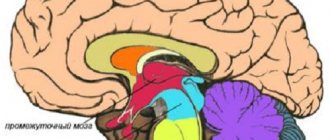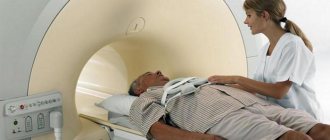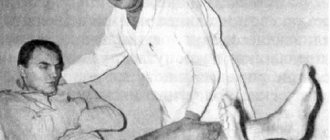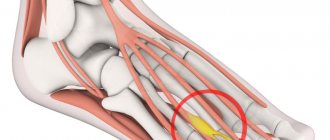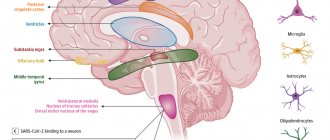Tetanus - tetanus - is the most dangerous bacterial infection that produces a deadly toxin that causes functional disorders in the human central nervous system.
It manifests itself as muscle hypertonicity syndrome and attacks of rapid and prolonged convulsive symptoms. It is distinguished by the rapidity of development and manifestation of characteristic signs of the disease.
- The first signs of tetanus, the development of the disease
- Symptoms of tetanus in humans, photo
- Stages of tetanus
- Treatment of tetanus, drugs
Preventive measures
Tetanus: how does infection occur?
The genesis of the development of tetanus is due to the influence of a rod-shaped, spore-forming microorganism of the Clostridium family, characterized by high resistance to survival in various environments. It successfully withstands disinfection and high temperatures, and can remain pathogenic (infectious) for many years.
It can be detected in the cloaca of birds, soil inseminated with spores, in dust particles and feces of various animals. Here it persists for a long time and reproduces successfully.
The infection enters the human body through contact, penetrating the bloodstream through the mucous membrane and wounds of any origin, be it a deep wound or a puncture from a splinter. The main routes of infection with tetanus can be:
- surgical and burn wounds;
- dog bites, puncture and wound wounds;
- dental and frostbite wounds;
- infection of newborns through the umbilical wound.
Agricultural workers and livestock breeders, and teenage boys are at greatest risk of infection due to excessive mobility, which causes frequent injuries.
Being infected with tetanus once does not mean that the body will develop immunity against it. Knowing how tetanus is transmitted, you need to protect yourself and your loved ones.
Causes
The cause of tetanus is the bacterium Clostridium tetani - an anaerobic rod with thickenings at the ends in the form of spores (for which it is called a “tennis racket” or “drumstick”). Spores are found in the soil (favorite ones are chernozem, red soil), in the intestines of herbivores, rodents, birds and humans. Among animals, clostridia is found in the feces of cows, pigs, horses, sheep, goats, rabbits, rats, mice, and among birds - in chickens, ducks, geese. According to some data, carriage of spores in the human intestine is possible in 40% of the population, mainly due to people living in agricultural regions and working in livestock farming. The presence of spores in the intestines is not dangerous for humans and does not cause the development of disease, but contributes to soil contamination. Spores reach a person directly from the soil through damaged skin or mucous membranes: in the presence of wounds, bites, burns, abrasions, punctures, or simply cracks in the skin (when walking barefoot). Clostridia are also carried through the air by wind and dust, settling in residential buildings, operating rooms, and industrial enterprises, i.e. everywhere. In medical institutions where there are patients with any wound surfaces, there is also a risk of contracting tetanus (if the rules of asepsis and antisepsis are not followed).
Tetanus clostridia are very stable: in soil, on the surface of furniture, clothing, they remain for decades, and are not exposed to chemical and physical factors (for example, spores can withstand a temperature of 90°C for 2 hours). Under favorable conditions (and this is the absence of oxygen, a temperature of 37 ° C, good humidity), the spores germinate into vegetative forms that produce toxins. Vegetative forms are less stable: they are destroyed by boiling and treatment with disinfectants. Toxins are destroyed by exposure to sunlight, heat, and an alkaline environment.
An increase in the incidence of tetanus is recorded in the spring and summer (“summer” season).
A person with tetanus is not dangerous to others. It is impossible to become infected while caring for a sick person.
The first signs of tetanus, the development of the disease
The first signs of tetanus, photo - unexpected cramps
The main symptoms of tetanus in humans are fatigue and muscle pain. Eating is accompanied by difficulty swallowing. There is a fever, rapid heartbeat and sweating. The first signs of tetanus begin to appear within a week after infection.
The starting point for the development of the disease is a slight spasm of the jaw and facial muscles. Sometimes the process may include: pectoral, cervical, dorsal, gluteal muscles and muscle bundles of the abdomen, accompanied by accompanying symptoms in the form of:
- high temperatures;
- hypertensive signs;
- rapid heartbeat;
- seizures
The infectious process is determined by four main periods of its course - incubation (latent), initial, the period of height of tetanus and the recovery stage. Each stage of development has its own symptoms.
Features of latent development
During the latency period, the infection does not have time to manifest itself with pronounced symptoms. It is possible to recognize the disease only by conducting special tests. The severity of symptoms depends on the length of the tetanus incubation period. The shorter this stage, the more pronounced the signs of the disease will be.
The latency of infection is due to different periods – from 2 days to a month. Typically, the duration of the incubation stage does not exceed 14 days. Precursors of the disease (prodromal) may appear:
- muscle spasms (involuntary twitching);
- excessive muscle tension in the injury area;
- migraines;
- vague feeling of discomfort and irritability;
- increased sweating.
Gradually, prodromal symptoms worsen, giving way to an acute clinical picture.
Details about the routes of transmission and infection of tetanus
Tetanus is one of the most serious and dangerous diseases. Mortality even with timely initiation of treatment is 50–70%. Fortunately, thanks to the invention of vaccinations and serum, the disease has become truly rare. But its pathogens are found everywhere, and everyone is likely to encounter them.
One of the ways tetanus is transmitted is through the ground.
Symptoms of tetanus in humans, photo
Symptoms of tetanus in humans, photo 3
The onset of the development of infection is characterized by a constant sequence of tetanus symptoms, which begin to manifest themselves as a pain syndrome associated with the tension of the nerve fiber in the area of the wound entry of the pathogen, even if the wound is already beginning to heal.
This is one of the very first signs of tetanus in humans, indicating the onset of a long-term infectious process.
This is followed by manifestations of tonic muscle spasm (trismus) of the temporomandibular zone, limiting chewing functions. The patient cannot open his mouth freely; in difficult cases, it is impossible to open it at all, due to tightly clenched teeth.
An involuntary convulsive contraction of the facial muscles is noted, causing on the face an expression of either a smile or crying, merged into a single mask. The muscles of the back of the head and pharynx spasm, resulting in symptoms of difficulty swallowing.
- The combination of manifestations of such signs occurs only in tetanus.
Signs of the height of the disease
The peak development of tetanus symptoms in humans occurs during the height of the infection, which can last from one and a half to two weeks, depending on the severity of the process. At this stage, convulsions are clearly visible, occurring completely unexpectedly or increasing gradually, lasting from a few seconds to a minute.
At the same time, they can be of such intensity that they literally break a person - they tear tendons, twist joints and bones. There is muscle tension, which does not subside even at night, and soreness throughout the body.
The muscle bundles of the abdomen harden, clearly outlining the contours of the muscles, motor activity is partially or completely blocked, the lower limbs freeze in an extended position. The skin shows signs of cyanosis and profuse sweating. The patient feels a strong deterioration in his condition, the following appear:
- signs of asphyxia causing respiratory dysfunction;
- apnea, manifested by periodic blocking of breathing;
- disturbances in the processes of urination and defecation, causing pain in the perineum;
- fever and profuse salivation.
Lack of timely assistance and treatment for tetanus with symptoms of such intensity can be fatal.
The healing process
Full recovery is preceded by a long stage of treatment for tetanus - up to two months. The amount of convulsive symptoms gradually decreases. It is at this stage, against the background of an improved condition, that various complicated processes can develop:
- rigidity (stiffness) of the muscular-ligamentous apparatus;
- muscle and joint tears;
- damage to bone tissue;
- development of secondary bacterial infections (sepsis, pneumonia, pulmonary atelectasis, pyelonephritis);
- the formation of phlegmon and abscesses in the area of the “entrance gate” of the infection.
Disease prevention
The main protection against tetanus is vaccination
Prevention of tetanus is to prevent the causative agent of this disease from entering the body. In case of injuries, do not rush to stop the bleeding; all the dirt may flow out with it; disinfect all wounds, do not come into contact with dirt with open wounds, wear gloves when working with the ground. But the main protection is vaccination.
When are tetanus vaccinations given? The first time the vaccination is given to three-month-old children, then repeated after 4.5 or 6 months. Then revaccination is carried out at the age of 1.5 years and at 6 years. The effect of such drugs lasts up to 10 years, so adolescents should repeat vaccination at the age of 16. This also applies to adults, who often neglect this requirement, based on the fact that they are no longer small children. Adults who are at risk are recommended to have a booster vaccination every 10 years.
There is a vaccination against diphtheria and tetanus: a two-in-one effect. It is called ADS-M ANATOXIN (manufactured in Russia) and there is its analogue IMOVAX DT ADULT (from France). But mono-vaccines are also used, that is, separated from each other, AS ANATOXIN for tetanus and AD-M ANATOXIN for diphtheria. Alcohol is contraindicated during tetanus vaccination.
There are also side effects of the tetanus shot. Among them: an allergic reaction (up to anaphylactic shock and bronchospasm), fever, arthritis, abscesses (in the place where the injections were given), damage to the nervous system, asthmatic attacks, arrhythmias, nausea, vomiting, diarrhea, urinary retention (rarely), menstrual irregularities. Since side effects cause great concern among people, they should consult a doctor with this question; only he can, after examining the patient, give consent to vaccination.
So, vaccination and compliance with safety measures is the best protection against tetanus. Be vigilant and don't get sick!
Stages of tetanus
The general assessment of tetanus in a person is based on the severity of clinical signs.
- The mild stage lasts no more than three weeks. Characterized by moderate spasms of the facial and back muscles. Clonic-tonic convulsions may be completely absent. The temperature may remain within normal limits or be slightly elevated. General symptoms appear no longer than a week.
- The moderate-severe stage lasts from 2 to 3 weeks. All symptoms appear and increase within three days. A convulsive syndrome is typical, occurring once a day. Signs of hyperhidrosis, tachycardia and low-grade fever remain within moderate limits.
- The stage of a severe infectious process is due to a short latency - one or two weeks. The manifestation and increase in the main symptoms occurs over the course of two days, it is intense and pronounced.
- The stage of the extremely severe course of the disease is characterized by a very short incubation stage (up to seven days) and immediate development - regular, prolonged convulsive syndromes, up to five minutes, and muscle spasms accompanied by tachypnea (shallow rapid breathing), signs of tachycardia, suffocation and skin cyanosis
What happens inside the body?
The disease does not develop because of the microbe itself. And as a result of the impact on the body of two toxins released during its vital activity. Tetanospasmin enters the central nervous system by penetrating the nerve endings extending from the site of injury, since the environment inside the nerves is liquid and there is a constant movement from the periphery to the center. Besides. An additional source of distribution of tetanospasmin are lymphocytes - white blood cells. The main damaging effect of this toxin is the disruption of the normal signal from nerves to muscles; it affects both directly at the junction of nerves and muscles, and at the level of the nerve trunks of the spinal cord.
In addition, tetanospasmin also affects the brain by binding to special molecules - gangliosides, which make up the bulk of brain tissue. As a result of these injuries, there is a sharp increase in neuromuscular excitability, resulting in clonic and tonic muscle spasms of the body, which can be provoked by any irritant - light. By sound or even touch. The spread of the process in the nervous system can cause paralysis of breathing and heart function. In addition, there are a number of serious disorders of the peripheral nervous system - hypertension, tachycardia, severe sweating. The introduction of antitetanus toxin can bind only that toxin that has not yet penetrated the nervous system, but cannot affect one that has already penetrated it.
Another characteristic is the fact that tetanus can be contracted again, immunity is not formed after the disease, and the only effective measure to combat it is vaccination with toxoid.
Treatment of tetanus, drugs
Due to the high risk of mortality with tetanus, patients are treated in a hospital with the participation of a resuscitator-anesthesiologist.
The patient is provided with conditions of rest and isolation from irritants. The feeding process is based on gastric intubation, or parenteral (intravenously), for gastrointestinal paresis. Treatment of bedsores and wounds through which the pathogen entered the body is carried out. Even if the wound is healed, it is treated with a special serum.
The wound is inspected. Incisions are made in the area where the infection is located for oxygen access, the wound is treated and cleaned of foci of necrosis.
Drugs for the treatment of tetanus:
- Enzyme preparations – “Trypsin” or “Chymotrypsin” – are administered. It is very important to introduce specific immunoglobulin preparations or PS serum into the body as early as possible.
- As symptomatic treatment, drugs that relax muscles (muscle relaxants), psychotropic drugs, and narcotic drugs are used. In severe cases - intravenously "Diazepam", Combinations of drugs - "Aminazina" + "Promedol" + "Diphenhydramine". It is possible to add a prolonged solution of Scopolamine.
- Sedatives in the form of “Seduxen”, powders, syrups, aqueous solutions with “sodium oxybutyrate”. In severe cases - Fentanyl or Droperidol.
- Among the muscle relaxants, curare-like drugs are “Pancuronium”, “Tubocurarine”.
- For emotional instability - “Alpha and beta blockers.”
- If respiratory functions are impaired, the patient is intubated, artificial ventilation with oxygen, aspiration (mechanical cleansing) or hyperbaric oxygenation.
- Problems of the gastrointestinal tract and urinary system are solved by installing a gas outlet tube, catheterization and laxatives.
- To prevent secondary infections, antibiotic therapy is included in the treatment plan.
- In case of acid-base imbalance and dehydration, correction is carried out with intravenous injections - solutions of “Reopoliglyukin”, “Albumin”, plasma-substituting agent “Hemodez-N”.
The prognosis of the disease is determined by the form of the course and the severity of the process. In the last severe stages of tetanus, with the rapid development of symptoms, death is often due to untimely provision of assistance and delayed treatment.
Mild forms of the disease, with appropriate treatment of the pathology, can be successfully cured.
Diagnostics
Laboratory testing does not make it possible to detect a toxin in the blood; even the most sensitive methods will not help with this. And the fact that antibodies can be found most likely indicates that tetanus vaccinations were previously given. The number of antibodies does not increase because this disease does not cause an immune response in the body, even if there is a large dose of the toxin in the blood. The disease can be diagnosed by conducting a histological examination of the damaged tissue, taking a smear from the site of penetration of the bacterium, or a sample from the wound, that is, from where the infection occurred. You can also examine the external environment where the patient could have become infected, to determine whether there are spores of the causative agent of tetanus there.
Basically, in addition to this, the doctor should pay attention to the symptoms that indicate the presence of this disease. But biochemical tests of urine, blood and cerebrospinal fluid show no deviations from the norm, and no negative changes are observed in the gastrointestinal tract.
Of course, there are similar diseases, for example, rabies, but with it there is no trismus and “sardonic smile”, and the muscles relax between convulsions. There are also a number of other similar diseases: tetany, strychnine poisoning, traumatic brain injuries, meningitis, epilepsy, meningoencephalitis, exacerbations of common osteochondrosis. These diseases can be distinguished from tetanus using appropriate symptoms and diagnosis - this is done by a doctor.
What kind of disease is tetanus
Tetanus (also known as tetanus) is a very serious infectious disease that affects the human nervous system. Tetanus is accompanied by severe painful cramps. At the same time, breathing becomes very difficult, which leads to the painful death of the patient.
Tetanus bacillus
The causative agent of the disease called tetanus is a spore-forming bacterium called Clostridium tetani (tetanus bacillus). This type of bacteria thrives in an environment where there is no air. For the bacterium itself, oxygen is destructive, but its spores are particularly tenacious. Therefore, closed deep wounds are favorable conditions for this bacterium.
Note: Like the diphtheria bacillus (“Diphtheria in children, the main symptoms of diphtheria”), the bacterium itself is not as dangerous to the human body as the exotoxins it produces are dangerous. It is these toxins that cause motor neuron disorders, which leads to characteristic seizures.
How is emergency prevention carried out?
Since this infection enters the body only through damaged skin or mucous membranes, the main method of prevention is to avoid wounds, abrasions, burns and other injuries. But such advice is not practical, so it is important to understand what to do in the event of a potential infection.
Knowing how the infection spreads, you can draw up a clear action plan:
- Immediately rinse the wound with clean water to remove all dirt and dust.
- Treat with disinfectants. Hydrogen peroxide helps well, as well as any other bactericidal liquids: chlorhexidine, miramistin, and so on.
- Contact a doctor, an emergency room, or an ambulance, depending on the severity of the injury.
The latter is especially important, because even with potential tetanus infection, emergency immunization is necessary.
To do this, a person is injected with immunoglobulin - purified and prepared blood serum containing antibodies to tetanus toxin. Two forms of this drug are used:
- Horse immunoglobulin. It is cheaper, more accessible, easier to manufacture, and therefore more widely distributed. But this drug has a relatively high allergenicity, so it is administered to weakened people prone to allergic reactions and children with caution, only after a test.
- Human immunoglobulin. It is much better tolerated, but is not always available, especially in small towns and villages.
For people who have not been vaccinated, the vaccine is often given along with immune globulin. This passive-active immunization accelerates the production of one's own antibodies. Afterwards, it is worth completing the course of immunization with a revaccination after 1.5 months.
But it is still safer and more reliable to do all the necessary vaccinations on time and repeat them periodically. Despite all the advantages and effectiveness of emergency prophylaxis, it is significantly more difficult to tolerate than a regular vaccination.
We hope that now you better know the ways and causes of tetanus infection, and what happens if timely vaccination is neglected. This means you will be able to consciously and reasonably make a decision if necessary.
Tetanus is an infectious disease of the sapronosis type (the name comes from the Greek sapros, meaning rotten, and nosos, meaning disease). Characteristic of this group of diseases is the contact mechanism of transmission of the pathogen and its habitat.
The habitat for tetanus bacteria is objects (not the human or animal body) located around us - for example, water, soil, chair, table. Thus, the causative agent of Legionnaires' disease, which belongs to this group of diseases, chose an air conditioner, shower and similar objects as its habitat.
Tetanus is not characterized by an epidemiological nature of spread, since the patient does not pose a danger to others - he is not contagious. Although immunity to tetanus does not develop after illness.
Tetanus after animal bite
The exact incidence of tetanus after bites is unknown. A fatal case of generalized tetanus after dog bites (usually a stray animal) is presented. The infection has no confirmatory laboratory tests and remains a clinical diagnosis.
However, a tetanus injection is necessary after a dog bite because the animal may be carrying the bacterium. Like rabies, this bacteria can also be transmitted through a dog's saliva and cause symptoms of the disease. However, not all bite victims need immediate vaccination. The patient does not require an injection provided that it was last administered no later than 5 years ago. If you are unsure of the exact date of the vaccine, it should be repeated within the next 72 hours after the animal bite.
Swallowing disorder due to tetanus
Dysphagia develops when there is a problem with the neural control or structures involved in any part of the swallowing process. This is exactly what tetanus infection leads to by disrupting the functioning of the nervous system.
Dysphagia refers to difficulty swallowing—it takes more effort than usual to transport food from the mouth to the stomach. Signs may include drooling, hoarseness and weight loss. There are two main types of dysphagia: oropharyngeal - a problem in the mouth and/or throat caused by a weakness of the tongue; Esophageal dysfunction (low dysphagia) is a problem in the esophagus. It is worth noting that the combination of symptoms such as “sardonic grimace” and dysphagia are characteristic exclusively of the manifestation of tetanus infection.
What is the outlook for people with tetanus?
Treatment is essential as soon as possible; without it, tetanus can be fatal. Death is more common in young children and older adults. About 11 percent of reported tetanus cases have been fatal in recent years, according to infectious disease departments. This figure was higher in people over 60 years of age, reaching 18 percent. In people who were not vaccinated, 22 percent of cases were fatal.
Friends! If the article was useful to you, please share it with your friends or leave a comment.


